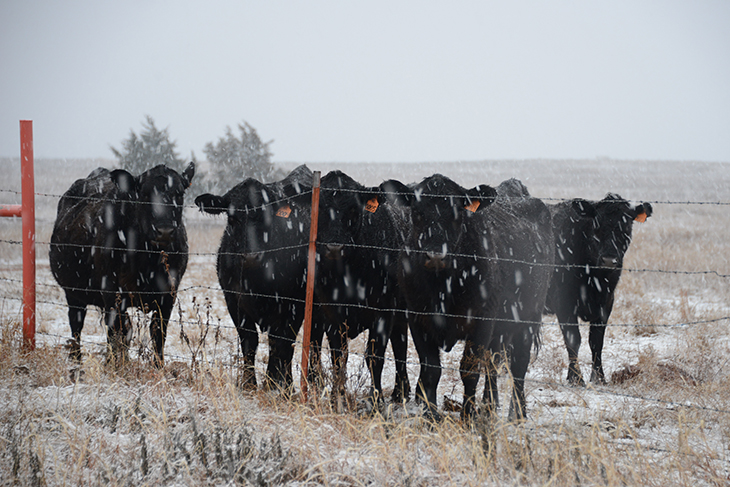
Winter weather may affect cattle market factors, animal performance
Monday, January 14, 2019
A major winter storm has hit much of the United States, from the middle of the country eastward to the mid-Atlantic coast, creating conditions sure to affect cattle performance in feedlots and beyond.
“Recent weather may delay fed cattle marketing enough to help support fed cattle prices or push prices higher,” said Derrell Peel, Oklahoma State University Cooperative Extension livestock marketing specialist. “Whether or not weather impacts are widespread enough to noticeably impact overall market conditions, cattle producers in specific areas of the country face significant management headaches.”
It is not unusual for winter weather to negatively affect feedlot performance and efficiency. Feedlots typically post the lowest seasonal average daily gains for cattle marketed in March to May, which reflects cattle fed over the previous four months to six months.
“This likely includes the negative impacts of winter weather on feedlot performance but also partly reflects the fact that feedlots place the highest proportion of lightweight cattle – which have lower average daily gains – in the fall and feed them through the winter,” Peel said.
Feedlots also experience poorer feeding efficiency during winter months, with the highest feed-to-gain ratios of the year posted for cattle marketed in February and March.
“This occurs despite the fact lightweight cattle placed in the fall have lower feed-to-gain ratios relative to heavier feedlot placements,” Peel said. “This again indicates the impact of winter weather on cattle feeding. Not surprisingly, feedlots post the highest animal morbidity and mortality rates for cattle fed through the winter.”
Wet, sloppy conditions are a major challenge in Oklahoma, especially across the southern half of the state.
“Oklahoma cattle producers typically are reluctant to complain about moisture in a place that so often suffers from drought, but exceptionally wet conditions this fall and winter have created significant headaches for cow-calf and stocker producers,” Peel said.
He added the past six months have been the wettest period on record for the statewide average, and represents the wettest period for the south-central region of the state and the second wettest for the southeastern and west-central regions. The southwestern, central and north-central regions have seen the fifth, sixth and seventh wettest periods, respectively, in the past six months.
The Oklahoma Mesonet’s Cattle Comfort Advisor helps producers adjust cattle management in adverse weather conditions. The index is based on temperature, wind, relative humidity and solar radiation.
“As has often been the case recently, rain or wet conditions that produce a wet hair coat on cattle mean the advisor index must be adjusted even lower,” Peel said. “In these conditions, cattle producers need to increase the quantity and often the quality of feed for cattle to avoid production losses or negative impacts on stockers and pregnant or lactating cows.”
Cash receipts for Oklahoma cattle exceed $3.7 billion annually, according to USDA National Agricultural Statistics Service data.
The Oklahoma Cooperative Extension Service is one of two state agencies administered by OSU’s Division of Agricultural Sciences and Natural Resources, and is a key part of the university’s state and federally mandated teaching, research and Extension land-grant mission.
